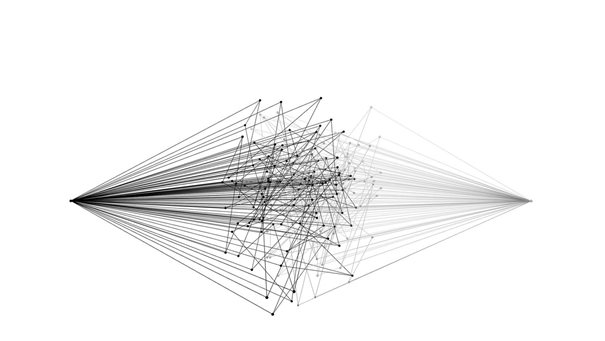Financial crime and fraud in the age of cybersecurity
As cybersecurity threats compound the risks of financial crime
and fraud, institutions are crossing functional boundaries to enable
collaborative resistance.
The evolution of fraud and financial crime
Fraud and financial crime adapt to developments in the domains they plunder. (Most financial institutions draw a distinction between these two types of crimes: for a view on the distinction, or lack thereof, see the sidebar “Financial crime or fraud?”) With the advent of digitization and automation of financial systems, these crimes have become more electronically sophisticated and impersonal.One series of crimes, the so-called Carbanak attacks beginning in 2013, well illustrates the cyber profile of much of present-day financial crime and fraud. These were malware-based bank thefts totaling more than $1 billion. The attackers, an organized criminal gang, gained access to systems through phishing and then transferred fraudulently inflated balances to their own accounts or programmed ATMs to dispense cash to waiting accomplices (Exhibit 1).
Exhibit 1

We strive to provide individuals with
disabilities equal access to our website. If you would like information
about this content we will be happy to work with you. Please email us
at: McKinsey_Website_Accessibility@mckinsey.com
Exhibit 2

We strive to provide individuals with
disabilities equal access to our website. If you would like information
about this content we will be happy to work with you. Please email us
at: McKinsey_Website_Accessibility@mckinsey.com
As banks begin to align operations to the shifting profile of financial crime, they confront the deepening connections between cyber breaches and most types of financial crime. The cyber element is not new, exactly. Until recently, for example, most fraud has been transaction based, with criminals exploiting weaknesses in controls. Banks counter such fraud with relatively straightforward, channel-specific, point-based controls. Lately, however, identity-based fraud has become more prevalent, as fraudsters develop applications to exploit natural or synthetic data. Cyber-enabled attacks are becoming more ambitious in scope and omnipresent, eroding the value of personal information and security protections.
In a world where customers infrequently contact bank staff but rather interact almost entirely through digital channels, “digital trust” has fast become a significant differentiator of customer experience. Banks that offer a seamless, secure, and speedy digital interface will see a positive impact on revenue, while those that don’t will erode value and potentially lose business. Modern banking demands faster risk decisions (such as real-time payments) so banks must strike the right balance between managing fraud and handling authorized transactions instantly.
The growing cost of financial crime and fraud risk has also overshot expectations, pushed upward by several drivers. As banks focus tightly on reducing liabilities and efficiency costs, losses in areas such as customer experience, revenue, reputation, and even regulatory compliance are being missed (Exhibit 3).
Exhibit 3

We strive to provide individuals with
disabilities equal access to our website. If you would like information
about this content we will be happy to work with you. Please email us
at: McKinsey_Website_Accessibility@mckinsey.com
Bringing together financial crime, fraud, and cyber operations
At leading institutions the push is on to bring together efforts on financial crime, fraud, and cybercrime. Both the front line and back-office operations are oriented in this direction at many banks. Risk functions and regulators are catching on as well. AML, while now mainly addressed as a regulatory issue, is seen as being on the next horizon for integration. Important initial steps for institutions embarking on an integration effort are to define precisely the nature of all related risk- management activities and to clarify the roles and responsibilities across the lines of defense. These steps will ensure complete, clearly delineated coverage—by the businesses and enterprise functions (first line of defense) and by risk, including financial crime, fraud, and cyber operations (second line)—while eliminating duplication of effort.All risks associated with financial crime involve three kinds of countermeasures: identifying and authenticating the customer, monitoring and detecting transaction and behavioral anomalies, and responding to mitigate risks and issues. Each of these activities, whether taken in response to fraud, cybersecurity breaches or attacks, or other financial crimes, are supported by many similar data and processes. Indeed, bringing these data sources together with analytics materially improves visibility while providing much deeper insight to improve detection capability. In many instances it also enables prevention efforts.
In taking a more holistic view of the underlying processes, banks can streamline business and technology architecture to support a better customer experience, improved risk decision making, and greater cost efficiencies. The organizational structure can then be reconfigured as needed. (Exhibit 4).
Exhibit 4

We strive to provide individuals with
disabilities equal access to our website. If you would like information
about this content we will be happy to work with you. Please email us
at: McKinsey_Website_Accessibility@mckinsey.com
From collaboration to holistic unification
Three models for addressing financial crime are important for our discussion. They are distinguished by the degree of integration they represent among processes and operations for the different types of crime (Exhibit 5).
Exhibit 5

We strive to provide individuals with
disabilities equal access to our website. If you would like information
about this content we will be happy to work with you. Please email us
at: McKinsey_Website_Accessibility@mckinsey.com
- Collaborative model. In this model, which for most banks represents the status quo, each of the domains—financial crime, fraud, and cybersecurity—maintain their independent roles, responsibilities, and reporting. Each unit builds its own independent framework, cooperating on risk taxonomy and data and analytics for transaction monitoring, fraud, and breaches. The approach is familiar to regulators, but offers banks little of the transparency needed to develop a holistic view of financial-crime risk. In addition, the collaborative model often leads to coverage gaps or overlaps among the separate groups and fails to achieve the benefits of scale that come with greater functional integration. The model’s reliance on smaller, discrete units also means banks will be less able to attract top leadership talent.
- Partially integrated model for cybersecurity and fraud. Many institutions are now working toward this model, in which cybersecurity and fraud are partially integrated as the second line of defense. Each unit maintains independence in this model but works from a consistent framework and taxonomy, following mutually accepted rules and responsibilities. Thus a consistent architecture for prevention (such as for customer authentication) is adopted, risk-identification and assessment processes (including taxonomies) are shared, and similar interdiction processes are deployed. Deeper integral advantages prevail, including consistency in threat monitoring and detection and lower risk of gaps and overlap. The approach remains, however, consistent with the existing organizational structure and little disrupts current operations. Consequently, transparency is not increased, since separate reporting is maintained. No benefits of scale accrue, and with smaller operational units still in place, the model is less attractive to top talent.
- Unified model. In this fully integrated approach, the financial crimes, fraud, and cybersecurity operations are consolidated into a single framework, with common assets and systems used to manage risk across the enterprise. The model has a single view of the customer and shares analytics. Through risk convergence, enterprise-wide transparency on threats is enhanced, better revealing the most important underlying risks. The unified model also captures benefits of scale across key roles and thereby enhances the bank’s ability to attract and retain top talent. The disadvantages of this model are that it entails significant organizational change, making bank operations less familiar to regulators. And even with the organizational change and risk convergence, risks remain differentiated.
The imperative of integration
The integration of fraud and cybersecurity operations is an imperative step now, since the crimes themselves are already deeply interrelated. The enhanced data and analytics capabilities that integration enables are now essential tools for the prevention, detection, and mitigation of threats.Most forward-thinking institutions are working toward such integration, creating in stages a more unified model across the domains, based on common processes, tools, and analytics. AML activities can also be integrated, but at a slower pace, with focus on specific overlapping areas first.
The starting point for most banks has been the collaborative model, with cooperation across silos. Some banks are now shifting from this model to one that integrates cybersecurity and fraud. In the next horizon, a completely integrated model enables comprehensive treatment of cybersecurity and financial crime, including AML. By degrees, however, increased integration can improve the quality of risk management, as it enhances core effectiveness and efficiency in all channels, markets, and lines of business.
Strategic prevention: Threats, prediction, and controls
The idea behind strategic prevention is to predict risk rather than just react to it. To predict where threats will appear, banks need to redesign customer and internal operations and processes based on a continuous assessment of actual cases of fraud, financial crime, and cyberthreats. A view of these is developed according to the customer journey. Controls are designed holistically, around processes rather than points. The approach can significantly improve protection of the bank and its customers (Exhibit 6).
Exhibit 6

We strive to provide individuals with
disabilities equal access to our website. If you would like information
about this content we will be happy to work with you. Please email us
at: McKinsey_Website_Accessibility@mckinsey.com
Efficiencies of scale and processes
The integrated fraud and cyber-risk functions can improve threat prediction and detection while eliminating duplication of effort and resources. Roles and responsibilities can be clarified so that no gaps are left between functions or within the second line of defense as a whole. Consistent methodologies and processes (including risk taxonomy and risk identification) can be directed toward building understanding and ownership of risks. Integrating operational processes and continuously updating risk scores allow institutions to dynamically update their view on the riskiness of clients and transactions.Data, automation, and analytics
Through integration, the anti-fraud potential of the bank’s data, automation, and analytics can be more fully realized. By integrating the data of separate functions, both from internal and external sources, banks can enhance customer identification and verification. Artificial intelligence and machine learning can also better enable predictive analytics when supported by aggregate sources of information. Insights can be produced rapidly—to establish, for example, correlations between credential attacks, the probability of account takeovers, and criminal money movements. By overlaying such insights onto their rules-based solutions, banks can reduce the rates of false positives in detection algorithms. This lowers costs and helps investigators stay focused on actual incidents.The aggregation of customer information that comes from the closer collaboration of the groups addressing financial crime, fraud, and cybersecurity will generally heighten the power of the institution’s analytic and detection capabilities. For example, real-time risk scoring and transaction monitoring to detect transaction fraud can accordingly be deployed to greater effect. This is one of several improvements that will enhance regulatory preparedness by preventing potential regulatory breaches.
The customer experience and digital trust
The integrated approach to fraud risk can also result in an optimized customer experience. Obviously, meaningful improvements in customer satisfaction help shape customer behavior and enhance business outcomes. In the context of the risk operating model, objectives here include the segmentation of fraud and security controls according to customer experience and needs as well as the use of automation and digitization to enhance the customer journey. Survey after survey has affirmed that banks are held in high regard by their customers for performing well on fraud.Unified risk management for fraud, financial crime, and cyberthreats thus fosters digital trust, a concept that is taking shape as a customer differentiator for banks. Security is clearly at the heart of this concept and is its most important ingredient. However, such factors as convenience, transparency, and control are also important components of digital trust. The weight customers assign to these attributes varies by segment, but very often such advantages as hassle-free authentication or the quick resolution of disputes are indispensable builders of digital trust.
A holistic view
The objective of the transformed operating model is a holistic view of the evolving landscape of financial crime. This is the necessary standpoint of efficient and effective fraud-risk management, emphasizing the importance of independent oversight and challenge through duties clearly delineated in the three lines of defense. Ultimately, institutions will have to integrate business, operations, security, and risk teams for efficient intelligence sharing and collaborative responses to threats.How to proceed?
When banks design their journeys toward a unified operating model for financial crime, fraud, and cybersecurity, they must probe questions about processes and activities, people and organization, data and technology, and governance (see sidebar “The target fraud-risk operating model: Key questions for banks”).Most banks begin the journey by closely integrating their cybersecurity and fraud units. As they enhance information sharing and coordination across silos, greater risk effectiveness and efficiency becomes possible. To achieve the target state they seek, banks are redefining organizational “lines and boxes” and, utility.
Most have stopped short of fully unifying the risk functions relating to financial crimes, though a few have attained a deeper integration. A leading US bank set up a holistic “center of excellence” to enable end-to-end decision making across fraud and cybersecurity. From prevention to investigation and recovery, the bank can point to significant efficiency gains. A global universal bank has gone all the way, combining all operations related to financial crimes, including fraud and AML, into a single global utility. The bank has attained a more holistic view of customer risk and reduced operating costs by approximately $100 million.
As criminal transgressions in the financial-services sector become more sophisticated and break through traditional risk boundaries, banks are watching their various risk functions become more costly and less effective. Leaders are therefore rethinking their approaches to take advantage of the synergies available in integration. Ultimately, fraud, cybersecurity, and AML can be consolidated under a holistic approach based on the same data and processes. Most of the benefits are available in the near term, however, through the integration of fraud and cyber operations.



No comments:
Post a Comment